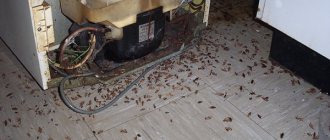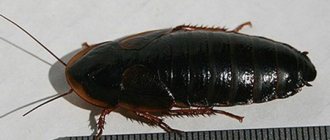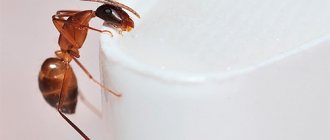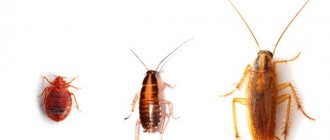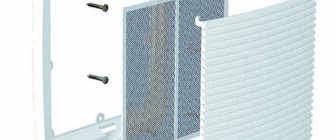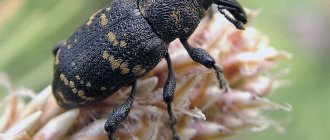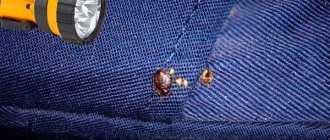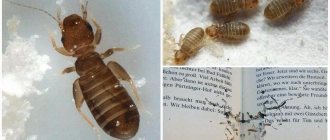In Russia, 4 types of cockroaches can be found in apartments and premises.
- Red cockroach.
He's a coward. The pest is copper or reddish-brown in color and measures up to 1.5 centimeters in length. Runs around, afraid of the light. One generation develops in approximately 2–4 months. The colony reproduces faster than other cockroach species. It often comes from neighbors, from basements, and ends up in food bags. - Black beetle.
It has a black or brown-brown body with a glossy sheen, measuring up to 3 centimeters in length. Development from egg to adult insect at home in a black cockroach takes about a year. The insect has wings, but does not use them. It comes mainly from sewers. - Furniture cockroach.
He is also a brown-striped cockroach. The body is oblong, beige or brown, with a reddish tint. It looks the same as the Prussian, but does not have the black stripes on its head. They mostly run; males can and willingly fly. Can be found in recently purchased furniture, things, and interior items. Unlike other species, furniture cockroaches are undemanding to moisture. They can be found in closets with clothes, cabinets with things, under the floor, in bedrooms and corridors. - American cockroach.
A red-brown or brown insect up to 5 centimeters in length. The largest cockroach found in apartments. American cockroach larvae look the same as adults, but are initially off-white in color and only darken over time. Can fly, but prefers to run. They come from sewers, less often through ventilation, and extremely rarely they can fly through windows. They are extremely demanding of moisture and heat, looking for conditions close to tropical.
The most likely sources of the appearance of certain types of cockroaches are only general guidelines, rules, to which there are always exceptions. Each case must be considered separately. The recommendations and information below will help you understand where cockroaches come from in your apartment or house.
The main reasons for the appearance of cockroaches in an apartment
Cockroaches, despite the fact that they are carriers of infections, prefer the most comfortable conditions, so if such conditions are created in an apartment, the pests are happy to settle there and stay for a long time.
In order to get rid of insects, it is important to know the reason. For example, if they come from neighbors, then you need to fight them together.
From neighbors
This is the most common way insects move. And there are several reasons for this:
- Bullying. When neighbors begin to destroy cockroaches with chemicals and other means with unpleasant odors, they quickly leave their previous place of residence, so they run to nearby apartments.
- Lack of food. If there are too many pests in the next room and there is no more food, they begin to look for new sources of food. To do this, the family sends “scouts” and after discovering food, they bring the rest.
- No water. For example, if your neighbors’ pipes and taps have stopped leaking, and there is no other liquid available in the public domain.
- Repair work. Cockroaches cannot tolerate the smells of many building materials, so they flee.
- Lack of place for daytime hibernation. If neighbors carefully seal all the cracks, then pests have nowhere else to hide.
Etching of cockroaches must be carried out jointly with the residents of the apartment building. If any of them refuses to do this, feel free to file a lawsuit, which will force them to carry out the procedure.
From the shop
Quite often, insects live in grocery stores and other stores, especially if they sell household appliances, which not only have a lot of hiding places, but are also warm. This often applies to TVs, which are always on in stores.
In other stores where there is unsanitary conditions, cockroaches crawl into bags on their own - to do this, just put it on the counter. They can be found in cereals, meat, fish and other products, which no one knows about.
From a long trip
During long journeys, a person stays in different places where cockroach families can be located. Unnoticed by you, they crawl through the microscopic cracks of suitcases and bags, are placed in electrical appliances, cosmetic bags, etc.
Even if you check things carefully, there may still be eggs in them, from which young individuals will later hatch.
Through the garbage chute
This is a favorite place for red-haired “aliens” - there is always something to eat here, but there is no clean water, so the pests move into apartments to get drunk. If their conditions suit them, they settle here for permanent residence.
Garbage chutes in old houses do not have tight-fitting lids, so the entrance/exit for cockroaches is always open.
With guests' belongings
If you invite people who have unsanitary conditions at home, be prepared for the fact that they may also bring cockroaches with them. They are usually hidden in bags, wallets, and gifts. As soon as the brought object remains motionless, the insects begin to climb out.
By mail
Cockroaches love to live in layers of cardboard, among paper, so there is nothing strange in the fact that larvae are found in the parcel. Insects end up in packages at the sender’s home and crawl out of the post office, as they live there thanks to the employees’ food leftovers.
The best advice is to open the parcel immediately upon receipt, carefully check and clean the items.
Other reasons
There are many more reasons why cockroaches appear in your home. Among which the following stand out:
- through a ventilation hole when insects are in search of new living conditions;
- from cafes, restaurants, shops and other establishments that are located on the ground floors of new buildings;
- from a sewer pipe - found immediately in the bathroom, distinguished by its large size and black color;
- when purchasing used equipment.
Habitats and breeding places for cockroaches in an apartment
There are the most comfortable conditions for red-haired “guests”, in the neighborhood with which they prefer to localize. Namely:
- abundance of food - these pests are omnivores, so they don’t care what foods are left on the table, they feed from unwashed dishes, from the trash can and everything else that attracts their attention;
- presence of water - running taps, unfinished drinks, wet sink (cockroaches cannot live without water);
- heat is an important indicator and it does not matter where exactly the appropriate temperature is (in the apartment itself, in the microwave oven, in household appliances);
- secluded places - cracks, refrigerator, furniture, decor, cracks in walls, etc. (they hide in them during the day and lay eggs).
Cockroaches consume not only food, but also paper towels, soap, and sheets of paper.
It is not easy to detect insects at first, so most often people find out about their presence when the insects are already breeding - just turn on the light at night and they will scatter in different directions.
Experts recommend paying attention to the following:
- there are traces of excrement in the form of black dots on the walls, baseboards and floors;
- a specific smell, but it appears when there is a large concentration of pests;
- eggs in crevices;
- remains of cockroaches in cabinets, on the floor (they look like hollow, dry shells);
- in complete silence - rustling, rustling, rustling, especially at night, when they are activated.
Most often, the place where cockroaches are localized is the kitchen and bathroom, where moisture is always present. To discover them in person, just look at these places:
- open household appliances (they will be inside);
- move the refrigerator;
- examine cracks and crevices;
- open the ventilation hole;
- remove the hanging shelves (located between the cabinet and the wall);
- move the baseboards.
The optimal habitat and breeding areas are hidden from human eyes. The presence of crawling insects in daylight is a sign of the prevalence of cockroaches, that is, there are already a lot of them.
Where do cockroaches live in the kitchen?
To successfully carry out self-disinfestation of an apartment, you need to know where cockroaches live in the kitchen. Some household insecticides demonstrate high effectiveness only if all insect habitats are thoroughly treated.
Cockroaches lead a secretive nocturnal lifestyle. They can go out in search of food during the day if there are no people in the apartment. But at the slightest threat, individuals immediately run away to shelter. Where do cockroaches hide? These are any dark, hard-to-reach places for humans:
- various cracks and holes in the walls;
- space under the baseboard, cabinets, stove, behind the refrigerator, microwave oven;
- socket boxes;
- distant dark corners under the sink, on the shelves;
- behind the heating radiator.
In habitats and along the route of movement of cockroaches, poisonous baits should be laid out and surfaces should be treated if folk recipes or weak drugs are used for control. They are capable of physically destroying an insect only upon direct entry into the body or contact with the chitinous cover.
Effective folk methods of disposal
The easiest way is to buy professional chemicals, but it is not always appropriate to use them, since they evaporate substances harmful to humans and pets into the air. In such cases, it is advisable to use traditional methods.
Boric acid
This is an organic product to which cockroaches cannot adapt, so it can be used for a long time. If you place boric acid in places inaccessible to children and animals, there is no threat to your health. But pests happily consume such delicacies.
There are also disadvantages - only individuals are destroyed, and the eggs remain alive, which is why you have to use the substance repeatedly (every 15-20 days, when new bugs hatch).
What you can do - recipes:
- mix 10 g of boric acid powder (this is 1 sachet) with raw yolk and 1 tsp. homemade vegetable oil, roll into balls, place around the apartment;
- add 1 boiled egg and a boiled small potato to 20 g of the substance, again add a little sunflower oil;
- dilute 10 g of acid in 500 ml of sweet water and spray the habitat.
You can also add other products to the balls that lure with aroma and taste - honey, jam, vanillin, sugar, etc. Don’t be afraid if the mass turns out to be runny - just add flour.
Homemade traps
This is the easiest way to catch cockroaches. To make a trap, any containers are used - cans, bottles, containers, plates. The main thing is that there is bait inside (water, sweets, leftover food).
How to make a water trap with your own hands:
- Prepare a plastic bottle (can be from a sweet drink bottle, unwashed).
- Cut off the top and neck just above the middle of the container.
- Pour water up to half of the resulting bowl.
- Unscrew the cap, turn this part over and insert it into the base.
If you are making a food trap:
- Place food in a glass jar.
- Lubricate the inside of the upper part of the container with vegetable oil/vaseline.
- Leave in a place accessible to insects.
- Check the traps every day, be sure to destroy any pests and add new food.
Chlorine
An aggressive but effective method, since cockroaches cannot tolerate the smell of bleach. Both dry powder and liquid solution are used.
Directions for use:
- sprinkle chlorine under the floor covering (linoleum, carpet, rug), along the baseboards, on cabinets, etc.;
- combine 500 ml of liquid white with 6-7 liters of water - wash the floor, walls, and other surfaces;
- dilute dry bleach with water (you should get a 2% solution), spray the accumulation areas.
After treatment, leave the room for at least 2-3 hours. If there are animals or children in the apartment, it is forbidden to scatter the powder, as it will release chlorine into the air for 5-6 days.
Freezing the premises
The method is used only in winter and during severe frosts (minimum -10°C). To carry out the procedure, follow the instructions:
- Turn off all electrical appliances and heating.
- Cover radiator pipes to prevent them from bursting.
- Open all the windows, and if this is a private house, then the doors.
- Leave the apartment for 4-6 hours.
The result is that the cockroaches run away, but to prevent them from returning again, take preventive measures.
Ammonia
The product has a pungent, persistent odor, so when using it, it is advisable to leave home for a day, but a minimum of 8 hours is acceptable. Rules for exterminating cockroaches:
- Mix 10 liters of water with 80-100 ml of ammonia.
- Rinse the floor and all surfaces.
- Close all windows and doors. Leave the room for 4 hours.
- Return to the house and perform the treatment again.
- Leave for another 4-5 hours.
Don't forget to wear a respirator and rubber gloves. Otherwise, you will get burns to the skin, mucous membranes and respiratory tract.
Warming up a room using a heat gun
Such methods are considered highly effective; they are used as an additional method by exterminators from the SES service. The temperature at which pests die is from +50°C and above.
For processing you will need a heat gun - a device that releases hot air. Instructions:
- Unplug the refrigerator and other household appliances.
- Turn on the thermal device.
- Direct it to places where cockroaches accumulate - under baseboards, cabinets, behind wall shelves, household appliances, under the sink, in crevices.
- Press the special button, process.
You can use liquid fog, but in this case you will have to leave the apartment for a day, since it settles for at least 10 hours.
Plants and herbs
Not all vegetation is tolerated by baleen insects, since many of them emit an unpleasant aroma. These are medicinal herbs, indoor flowers and other plants, among which the following are especially distinguished:
- geranium growing on the windowsill;
- mint, lemon balm;
- wormwood;
- elder;
- Bay leaf;
- honeysuckle;
- anise;
- tansy;
- wild rosemary;
- eucalyptus;
- medicinal chamomile.
Application options:
- hang with branches in the kitchen;
- Pour crushed herbs into woven gauze bags, hang or spread around the room;
- set fire and fumigate the apartment.
Remember that plants should always be indoors and should be periodically replaced with new ones.
Pyrethrum, which is sold in pharmacies and is made from chamomile inflorescence and is available in crushed form, deserves special attention.
Other folk remedies
Pay attention to other folk methods of getting rid of cockroach infestations, which are also considered effective. Among them:
- Borax. It is made from boric acid, so it is poisonous. Mix 190-200 g of borax with 25 g of vanillin, 1 boiled potato and 1 hard-boiled egg, roll into balls and place on surfaces.
- Arsenic. Just sprinkle the poison under the sink, along the baseboards, etc. Please note that children and pets should not be in the room.
- Gypsum. Buy construction alabaster, add a bait product to the powder, but only in dry form, since hardening will begin upon contact with a damp environment. This process must take place in the cockroach's stomach, which is why it will die.
- Essential oils. They act as a deterrent. The oil used is mint, geranium, citrus, lavender, cedar, eucalyptus and fir. In order for the red bugs to escape, leave the ether in an open container in all rooms. Another option is to pour 8-10 drops into 500 ml of water and carry out the spraying procedure.
- Sticky tapes. Buy fly tapes and secure them to any surface. The second variation is to use double-sided tape, glue it to a piece of cardboard, and place the attracting food on top in the center of the sticky surface. When enough cockroaches have stuck, change the tape.
Types of domestic cockroaches, harmful and exotic (bred), their characteristics
More than 4,500 species are now known, of which only 55 species are found in the CIS. And apartments are inhabited by only 3 species: red (Prussian), black and American.
Red cockroaches
Prusaks, or red cockroaches, can fly, but not for long. Adults come in different colors and are up to 1.6 cm long. They live in colonies. Life expectancy is about 6 months from the moment of hatching. They practically never meet without a person.
Males are oblong, wings peek out from under the elytra. Can fly short distances. Females are more rounded, without clearly defined wings. At one time, up to 40 eggs are laid in a capsule, which is worn for 2-4 weeks until the nymphs emerge from it. Nymphs are darker than adults and have no wings. After 2 months and 6 molts, the nymph turns into an adult.
After molting, the cockroach is much lighter, translucent, but this passes quickly, after 1-2 days they darken. Adults live up to 4 months. Over the course of her entire life, the female makes 4-9 clutches in the ootheca, that is, up to 400 eggs from one individual in just six months.
Their homeland is southern Asia, so they cannot tolerate cold at all, so when cooled to -5°C they die, and they feel so good in human habitation. The Prusak is omnivorous; in case of hunger strike, it can even chew soap or plaster. Does not tolerate thirst well.
Black beetle
They are much less common than redheads. They, unlike the Prussians, can live both among people and in the wild, not far from human habitation. They prefer warm, damp places (sewers, mines). The size of an adult cockroach reaches 8 cm. Representatives of this species run fast, but cannot fly.
American cockroach
Large (up to 5 cm), with a red-brown shell. Capable of running up to 75 cm/sec, while changing directions of movement up to 25 times. It flies, but rarely. It is impossible to catch with your hands. They have a powerful mouthparts (they chew through pieces of wood and plastic) and eat everything, even hair and shoes.
Very thermophilic - they die in minimal frost. They live in huge colonies (tens of thousands of individuals).
During mating games, the male runs around the female and flaps his wings. This is due to the pheromones secreted by the lady. After fertilization, the pregnant female first carries a capsule with eggs (up to 2 days), after which she buries the ootheca into the substrate. BUT! The female can lay eggs without fertilization by the male.
Furniture cockroach
Officially recorded only 100 years ago. Similar to Prussians, but smaller (up to 1.2 cm). The body shape and shade may vary, but the main feature is 2 stripes along the body. The color of these pests ranges from bright brown with a red tint to almost black. They run and jump very fast.
They tolerate a lack of water more easily than other species; they love starchy food (any paper, paste). The optimal temperature is about 30°C and high humidity.
Vietnamese (Turkestan) cockroaches
They live in houses, in landfills, and in the wild. Yellow, with a dark brown tint. An important feature of this species is jumping and flying. They consume plant remains and debris from human activities.
Egyptian cockroaches
These pests live in Asia, in the Caucasus and Crimean mountains. The brown color and rounded body shape make this species look like a turtle. Males are winged, females are not. Large (up to 4.5 cm), they live on farms, in houses, and animal burrows. They eat all types of organic waste, including excrement. They can starve for more than 3 months, but the lack of water is critical for them.
At one time, the female lays up to 18 eggs; in total, she can lay up to 5 ovipositions during her life. It takes 2 years from birth to adulthood, during which time it sheds several times. The adult stage lasts another 2 years.
The harm from this type of cockroach is enormous, since after eating the insects, the animals become infected with paratyphoid.
Madagascar cockroach
Giant individuals (up to 10 cm) are known for their hissing. This is how they try to scare the enemy. Unpretentious, omnivorous. These are viviparous insects. They prefer humidity and warmth, like representatives of other species of the cockroach family. They are bred as pets or as food for snakes and lizards.
Rhino cockroach
A large beetle up to 8 cm and weighing about 35 g (only 2 times lighter than a sparrow). Chocolate color. A good digger, excellent at digging tunnels. It is massive (40 g). Consumes parts of plants, but will not refuse particles of dead animals.
Rhinoceroses are clean and do not smell. They do not fly and cannot crawl on glass, so they are excellent for keeping in aquariums.
Chess cockroach
Representatives of this species stand out among their relatives with their beautiful checkerboard colors. Found in India. They grow up to 3 cm. They love warmth and moisture (above 70%), prefer night walks.
banana cockroach
It has an unusual green color. Can fly. Prefers to live on banana plantations, consuming parts of plants and fruits.
Forest cockroach
An inconspicuous inhabitant of wooded areas (up to 11 mm), eats everything it finds (all kinds of greenery, carrion). During the day it hides under the grass or in the roots of bushes and trees. Translucent body of brown-golden color. There is a black spot on the head, the wings extend behind the body. It is not very dangerous for humans, as it cannot even bite through the skin of a finger.
Little car
They got their name thanks to two spots on their head that look like car headlights. They reach 5 cm and prefer not to be seen by people. They grow slowly, love mating games and competition for the female. They don’t fly or crawl on glass, so they often join the ranks of pets.
Dead Head
This large insect (up to 5.5 cm) received its name due to its frightening colors. It eats small insects, and if there is a lack of food, it will not disdain its relatives.
Marbled (ash) cockroach
It comes from Africa, but is found in most countries, as it is very undemanding to conditions and food, and reproduces well. It is also called naufet. The insect reaches 3 cm.
It feeds on raw vegetables, fruits, various grains, flour products, and does not disdain paper and thin plastic. They can eat each other when there is a lack of food. Often grown to feed reptiles and large spiders.
Sarawak cockroach
The difference between this species and others is the ability of the larvae to swim well. They prefer to live close to sources of moisture; in case of danger, they can dive to the bottom and hide there. Otherwise, their habits are like those of other relatives.
Megalobat cockroach
This longhorned beetle is hard to miss - Megaloblatta longipennis is considered the largest representative (9.7 cm by 4.5 cm in width). And its close relative (Megaloblatta blaberoides) has the largest wingspan (18.5 cm).
Lapland cockroach
Brown-brown, with a black dot, reminiscent of dry leaves. Found in Europe and America. Reaches a length of 1.4 cm. Fast, not demanding.
Asiatic
Found in areas with a tropical climate. The closest relative of the Prussian. Prefers to live outside, hiding under a layer of leaves. The population increases in the warm season and decreases in the fall.
Blaberus cockroaches
Large and colorful Blaberus giganteus hides well among foliage and grass. Found in various parts of America. They grow up to 9 cm in length.
Professional approach
These are radical methods that most often involve the use of aggressive substances that are harmful to the health of humans and pets, so you must act carefully. But there are also safe devices that do not have special requirements for operation.
Purchased funds
There are products on sale that have been used by humanity for decades. But you can also find innovative developments. Main types:
- Syringes with gel. Safe for health, quickly applied, easily washed off, but destroys only those individuals that are already crawling (does not apply to eggs). The gel will have to be changed once a week. To use, simply squeeze the gel-like mass onto a piece of paper or any surface using a dotted method. Well-known brands - Raptor, Dohloks, Absolut.
- Crayons. These are Mashenka, Brownie, Tornado, etc. Pencils are harmless; they are used to draw solid or dotted lines in places where there are large concentrations of cockroaches.
- Traps. These are structures with holes containing bait substances inside. An insect that gets into a trap spreads poison throughout the family. The most famous brands are Kombat, Raptor, Dohloks.
- Powders and granules. They scatter over surfaces, consist of substances that are poisonous to insects, and do not destroy larvae. The powder needs to be renewed twice a week. Example - Super Fas, Phenaxin, Clean House, Absolute.
- Aerosols. They contain elements harmful to humans, so after spraying on surfaces (walls, tables, floors, etc.), you must leave the house for at least 2-3 hours, then thoroughly rinse the surfaces with which you come into contact. Popular brands are Get, Raptor, Dichlorvos, Regent, Ultra Magic.
- Ultrasonic repellers. These are devices that operate on mains power or batteries. A mechanism is built inside that emits ultrasonic waves, to which only insects and small rodents react. The device causes cockroaches to escape from the room. If they do not have time to do this, then the nervous system is affected, after which paralysis and death occur. There are such brands on sale as Typhoon, Rexant, Tsunami, Tornado.
Calling specialists
If you do not have the opportunity or desire to hunt cockroaches on your own, or for some reason it is impossible to remove them, contact a special service. But before that, talk to the residents of the apartment building, since the destruction must be comprehensive.
Otherwise, after treating your territory, the pests will move to other apartments and then return again. You can contact the city SES, especially if there are cockroaches in the basement. In this case, the city authorities provide the service free of charge.
You have the right to choose a private pest control company, but you will have to pay at least 2-3 thousand rubles. How the procedure goes:
- Specialists treat the entire room using steam and chemicals.
- You leave the apartment for 5-10 hours, depending on the means used.
- Upon return, thoroughly wet clean.
Be sure to remove dishes, towels and other items first. Cover the furniture tightly with film.
What should you do before removing cockroaches?
Preparation for the procedure of baiting cockroaches is carried out to increase the effectiveness of the products and safety. What you need to do first:
- Decide on a method to get rid of insects. And buy the product if required.
- Prepare protective equipment. Rubber gloves (preferably high, reaching to the elbow) and a respirator (it is recommended to take with additional protective filters). This is a mandatory requirement when using substances harmful to the body.
- Remove food and sources of moisture. To do this, remove all food and liquids from the kitchen. If baiting is done using safe methods, make sure every day that there are not even crumbs left anywhere, as well as a full trash can and water. Without food, cockroaches live for about 20-30 days, but without water they die after 5-7 days.
- Do a thorough cleaning. Wash the floors with bleach/bleach, wipe the window sills, sweep away all debris, crumbs, etc.
- Seal any cracks through which cockroaches may pass. To do this, buy a special solution or putty at a hardware store. Pay attention to cracks in the wall, cracks near water pipes. Be sure to hang a device with a very fine mesh (like a mosquito net) on the ventilation hole so that pests cannot escape from the apartment through it.
- Warn your neighbors about the impending “attack.” Let them prepare too. Otherwise, your pests will be able to move in with them. But even better, agree with them on joint destruction.
- Prepare the poison. Mix the required ingredients if necessary.
Prevention of cockroaches
To prevent cockroaches from ever visiting your home, pay attention to preventive measures.
Prevention methods:
- Take out the garbage before going to bed or at least tie the garbage bags tightly;
- do not put garbage in a bin, use bags;
- keep it clean - wash the floors at least 2-4 times a week;
- do not leave crumbs and other food items in the public domain;
- do not eat outside the dinner table;
- remove all water sources at night, wipe the sink and bathtub, close the toilet;
- seal the cracks and hang nets on the ventilation compartments;
- periodically wash the floor with bleach;
- plant geraniums or lemon balm on the windowsills;
- use aroma lamps with repellent essential oils;
- for prevention, apply chalk pencil or gel to inaccessible areas;
- repair a leaking faucet or pipeline.
By following these simple rules, you will be freed from an infestation of cockroaches, but still be vigilant, as longhorned beetles enter the house from the store, etc.
To avoid bringing insects back from your trip, experts recommend placing mint and eucalyptus leaves inside your suitcases, or placing sachets with repellent plants.
Don't give up on cockroaches
For a long time, cockroaches were considered companions of hostels and disadvantaged residents in apartment buildings. In fact, the Prussians are a misfortune that can happen to any of us, regardless of status, financial well-being and perfect cleanliness in the house.
Today you are a clean owner, and tomorrow arthropods appear in your home and literally crawl out of every crack. Therefore, there is no need to be ashamed and put off resolving the issue; the sooner we start pest control, the faster we will defeat the mustachioed enemy. But first, let's find out how he got into our house.
Popular questions
People faced with the problem of cockroach infestation have a number of questions that are difficult to find answers to on their own, so experts are happy to share their knowledge.
Does the method of removing cockroaches depend on their species?
Red and black cockroaches most often live in private houses or high-rise buildings. They differ in size and method of survival:
| Peculiarities | Red-haired individuals (Prussians) | Black pests (sewer) |
| Preferred Residence | Near people and above ground level, so it is difficult to eradicate completely as they return. | In sewers, basements, that is, where there is practically no light. They do not appear after destruction. |
| Water requirement | Medium, which is why even after eating poison they can live safely for several days. | Increased, so they move easily even in water. If access is completely blocked, they die or leave. |
| Reproduction | Swift and numerous. Red-haired barbels carefully hide their future offspring. To get rid of it, you will have to carry out the procedures repeatedly - as newbies appear. | Slow and irresponsible - they lay eggs anywhere and leave them unattended. It is easy to find larvae, and after baiting it is enough to treat the room 1-2 more times. |
| Where are they coming from? | From the garbage disposal, ventilation, etc. There is an increased risk of return. | Through toilets, holes in sinks and bathrooms. Extremely rarely - by land. To prevent the occurrence, it is enough to close the toilet lid tightly and install strong small mesh over the holes in the sinks/bathtubs. |
| Dimensions | From 1 to 2 cm. It is difficult to detect at a young age, but small parameters contribute to the rapid perception of toxic substances. | From 3 to 5-7 cm. Easy to see, but more toxic agents are needed. |
| Type of movement | It is very fast, so it is impossible to act, for example, with a spray directly on an insect. | Slow, so you can spray on a cockroach and it will die immediately. |
Based on such a colossal difference, focus on one factor or another. For example, when black beetles appear, use more products; if you find red longhorned beetles, treat the room at least 3-4 times.
Are cockroaches dangerous for people and animals?
Cockroaches pose a huge danger to human life and pets. The main reason is the spread of infection through the paws, especially since it is unknown where the bug was running before entering your territory. Perhaps it was an infectious person, a garbage dump, etc.
What diseases arise from cockroaches:
- tuberculosis and pneumonia;
- helminthiasis and salmonellosis;
- dysentery and cholera;
- herpes and giardiasis;
- fungus and toxoplasmosis;
- enterovirus, allergies, skin diseases, etc.
Not only the infection brought is dangerous, but also the chitinous shells that cockroaches shed and their excrement. Over time, they transform into a dusty mass that clogs the respiratory tract.
Other dangers:
- chew small wiring in household appliances, which leads to short circuits and fire;
- bite a person;
- crawl into the nasal passages and ears;
- localized between eyelashes and hair.
Can cockroaches leave on their own?
They are not ready to leave the places where they are comfortable, but there are cases when cockroaches leave the territory on their own. There are the following reasons for this:
- they renovated the apartment and sealed all the cracks (they don’t like the smell of paints, varnishes and now have nowhere to hide);
- the owners left for a long time, turning off the water, so there is no longer any food or liquid left (they are forced to leave in order to survive);
- The plumbing has been fixed, so there is no longer access to water (this happens more often where there are no unsanitary conditions).
Scientists around the world are still understanding the problem of electromagnetic radiation and tend to think that the waves emanating from many household appliances, smartphones, and computer equipment can scare off and even lead to paralysis of insects.
What to do if cockroaches run away from neighbors and how to destroy them in the entrance?
To prevent cockroaches from entering your apartment from your neighbors, be sure to use prevention methods and exclude comfortable conditions for them. If there are too many insects in the house and you see them even at the entrance, immediately call the city SES.
Specialists are required to respond immediately. But even better, write a collective statement.
Knowing where cockroaches come from in a clean, well-kept apartment, you can prevent their invasion, but even if they have already appeared, use different methods of baiting. There are many of them, so you can choose the best option for you. Consider the presence of children and pets.
General characteristics of domestic cockroaches
All representatives of cockroaches have an elongated, flattened, oval-shaped body. Sizes vary from 1 to 10 cm (and more). There are tergites (segments) on the body - up to 10 in the male, up to 7 in the female. The wings are transparent, with membranes, hidden under dense elytra. Many species fly. The legs are adapted for fast running, with spikes. The ovipositor is hidden in females.
The flat head is heart-shaped, with a protective plate from the back. Long antennae with bristles. The jaws are powerful, with sharp chitinous teeth. The eyes are large and atrophied in wingless representatives.
Almost all species of this unpleasant insect love comfortable conditions in the form of warm and humid places, prefer night life, and during the day they hide under stones, leaves, bark and in similar hiding places in human habitation. At night they climb and fly into bright light.
They are considered extremely hardy. They are not afraid of hunger or radiation, and almost immediately develop resistance to most poisons. Can withstand radiation levels 15 times higher than humans (safe levels of radiation will depend on developmental stage).
They can go without food for up to 4 weeks, but are practically omnivorous. They love sweets and fatty foods, but with their mega jaws they grind everything from leather, books, wood to feces and any waste. They enjoy eating plants, fruits and vegetables. Males eat up to 30 g per day, while females can eat up to 50 g.
